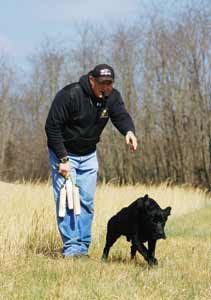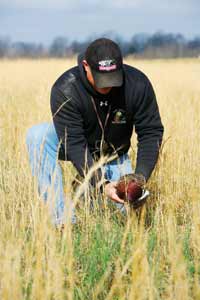Some off-season tips to get your dog hunt-ready.
By James B. Spencer
 Summer is a great time to combine regular non-slip training with more casual upland work Photo by Clay Connor. |
"Jim," Howard Brickley said, "why don't you just let that dog hunt?"
He said this during a mid-summer training session many years ago, when he saw me teaching a golden retriever to quarter in the uplands. The late Howard Brickley was something of a guru among dog folks whereabouts. He had done it all: pointing dogs, retrievers, and especially spaniels; field trials, obedience trials, and whatever else was available. So whenever he spoke, I listened. Thus, I ceased teaching that golden, or any retriever, "flat-pattern" (windshield wiper) quartering.
Sure, it can be done, but each dog can absorb only so much formal training before his brain's overload light begins to glow. Marking and especially the endless complexities of the blind retrieve pretty well fill the typical retriever's capacity for regimented learning.
Happily, any retriever that is well-trained in these skills can be turned into a journeyman upland flusher without additional training. True, he won't have the slash, dash, and polish of a well-bred, well-trained spaniel, but he'll get the job done. All you need to do with such a retriever is, as Howard Brickley said, "just let him hunt."
How It Works
If your retriever understands a release command, obeys the Sit-whistle and the Come-in whistle and is accustomed to gunfire, he already has all the formal training he needs for this quite informal kind of upland work. With your release command (Okay or whatever), turn him loose to hunt. When he flushes a bird, shoot it, and let him retrieve it. After a couple such delightful experiences, he'll understand and love this new game. For him, it'll be pure pleasure, with no additional pressure.
Controlling him will be easy. When he pushes too far out, stop him with the Sit-whistle and make him wait until you catch up. When he swings too far to either side, bring him back with the Come-in whistle; when he's again within your comfort zone, release him with Okay. When he gets too far ahead while trailing a runner, stop him with the Sit-whistle until you catch up, and then release him to continue trailing.
Such stop-and-go trailing, typically through light to moderate cover, usually results in a flush within 20 yards of you. When he chases a fly-away (a hen or a missed bird), stop him with the Sit-whistle, and call him back with the Come-in whistle.
It's that simple. Granted, he won't be steady to flush like a proper spaniel, that is, he won't sit immediately after flushing a bird and wait until you send him to retrieve. If you want that refinement, you'll have to train him for it. (For information on how to do this, see my book, HUP! Training Spaniels the American Way, available from the Gun Dog Bookshelf.) But do you need it? If you hunt mostly pheasants, you really don't.
Pheasants usually flush and fly high, so a chasing dog almost never interferes with the shooting. If you hunt birds that often skim the cover, like quail, you should either steady your retriever or expect to pass up a few shots. It's your choice.
Why A Summer Warm-Up?
Clearly, you can start hunting your retriever in the uplands next fall with no additional training. He'll catch on after he flushes a couple of birds. However, during the off-season, working him in the uplands in this informal manner with planted birds can be almost as much fun as hunting for both of you. You get to shoot birds and he gets to flush and retrieve them, a win-win situation.
 After planting pigeons to introduce your retriever to upland work, you might want to invest in a pheasant or two. Photo by Clay Connor |
Then, too, in your regular summer non-slip training sessions, you should always end on a positive note. This makes your dog eager to go out again next time. It also makes the rest of your day more pleasant. This is especially true after a frustrating session, one that perhaps leaves both man and beast gnashing and grinding teeth. What better way to lighten up and leave the training grounds happy than with a simulated upland "hunt"?
Nota bene: Since it's summer, take care not to over-heat your dog during these upland finales. Work near water; keep your dog wet; and carry drinking water for him. Also, make these sessions short, no more than two or three flushes, perhaps 50 yards apart. Afterwards, give him a splashy water fun-retrieve, and then home-again, home-again, jig-a-dee-jig. Happy dog. Happy trainer.
What You Need
You need at least one and preferably several patches of decent upland cover near a pond or stream, all of which at least some of your regular training areas surely have. You need birds, and pigeons will do nicely. If you have a few dead pigeons in your freezer, they'll do for your first couple of sessions. Thereafter you'll need live fliers and "clip-wings" or "clips." You can turn any live flier into a clip by pulling the flight feathers from one wing, thereby upsetting the bird's balance so it can't fly away, but can flop around and flee enticingly when your retriever approaches.
You need your shotgun and a few shells. You won't need an assistant, but if you know a cool-headed dead-eye, you might invite him to come and enjoy some of the shooting (especially if he has access to some prime hunting grounds you've had your eye on).
You do not need, and should not use, the little bird release traps pointing breed trainers use. A flushing dog can injure himself on these contraptions, especially if you push the release button a little too slowly.
When To Use Which Birds
You can use dead pigeons at first, when your dog is figuring out what's going on. After he's retrieved dead birds for a couple of sessions, you'll be able to tell from his attitude that he "gets it." Thereafter, you should use clips and fliers.
Start off with clip-wings to encourage a vigorous flush. When your dog approaches these birds, they flutter and scamper, but can't get away. Catching clips convinces your dog that he can catch birds if he's quick enough. This encourages a "fly or die" flush that eliminates the running option from the bird's repertoire of self-preservati
on ploys. Later on, when you're shooting fliers over him, mix in enough clip-wings to keep him flushing boldly, especially if he starts pointing.
When using and shooting fliers, ride them out before shooting so they can get up plenty high. Your retriever will love seeing them fall to your gun while he's in hot pursuit. However, you should let them fly away often enough to make sure you can stop him with the Sit-whistle before he chases a fly-away too far. Then, to make him glad he stopped, call him back with the Come-in whistle, and as he approaches you, toss a dead bird or clip-wing off to either side and let him retrieve it.
Planting Birds
To start this delightful summer game, leave your dog in his crate, where he cannot watch you as you plant the birds. Walk into the wind and along the center line of your chosen field, tossing birds off some distance to either side, one to the left, the next to the right, about every 50 yards. By staying in the middle, you make it impossible for your dog to trail you to the birds.
Tossing dead pigeons and clip-wings is no problem, but to put a live flier on the ground effectively is an art form. First, you must dizzy the bird enough to keep it on the ground until your dog finds it, but not so much that it won't flush at all. To dizzy a bird, hold it by its body and twirl its head around in a circle.
How much? It depends on its size and strength. With experience, you'll become quite adept at dizzying each pigeon about right. When you overdo it, your dog will catch the bird on the ground, which is not a problem. When you under-do it, the pigeon will fly away before your dog gets to work it, which is unfortunate but not a show-stopper.
Let The Games Begin!
With the birds planted, get your retriever out, take him to the starting point, and turn him loose into the wind. At first, walk zigzag to encourage him to cover the ground. Later on, he'll cover it while you walk straight up the middle.
Thereafter, you should, as Howard Brickley told me years ago, "just let that dog hunt!"
Nota Bene: James B. Spencer's books can be ordered from the Gun Dog Bookshelf. They are: Training Retrievers for Marshes & Meadows; Retriever Training Tests; Retriever Training Drills for Marking; Retriever Training Drills for Blind Retrieves; Retriever Hunt Tests: A Handler's Guide to Success; HUP! Training Flushing Spaniels the American Way; POINT! Training the All-Seasons Bird Dog; and the Gun Dog video, Duck Dog.






